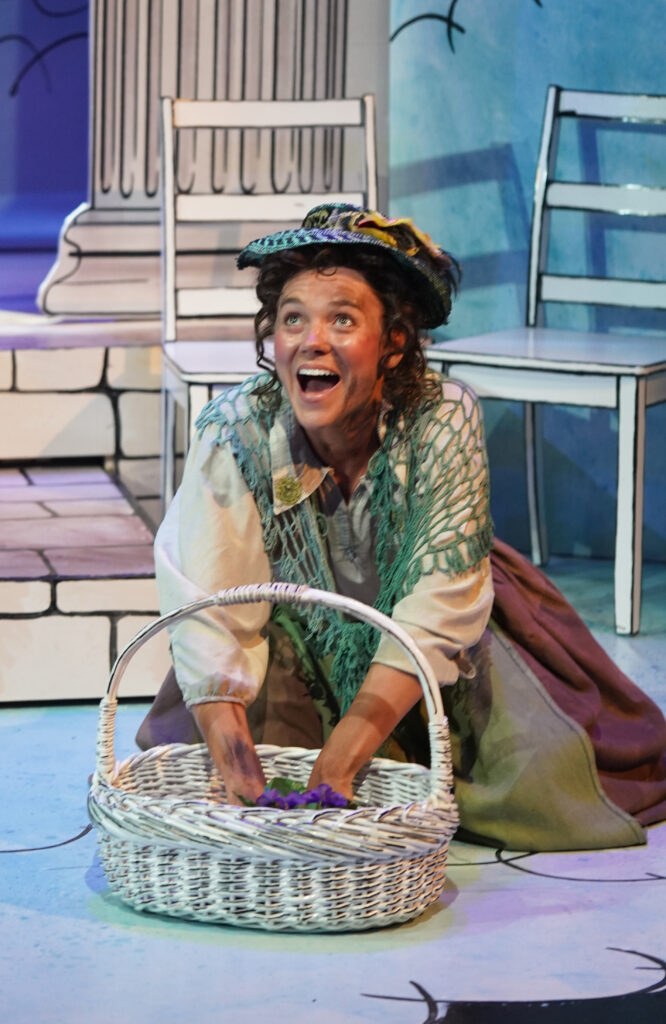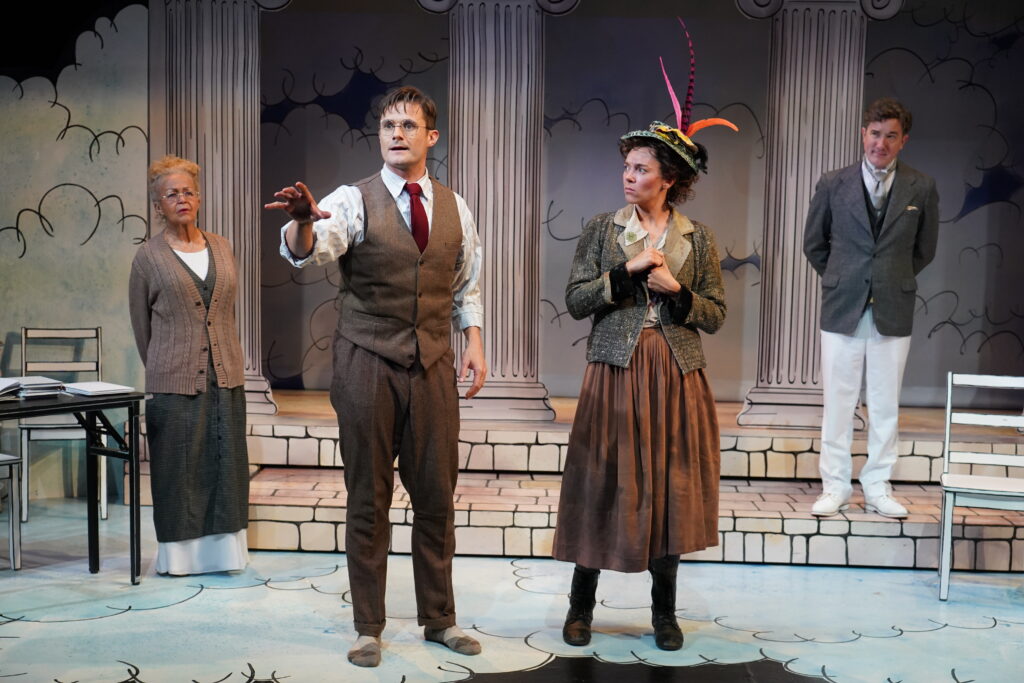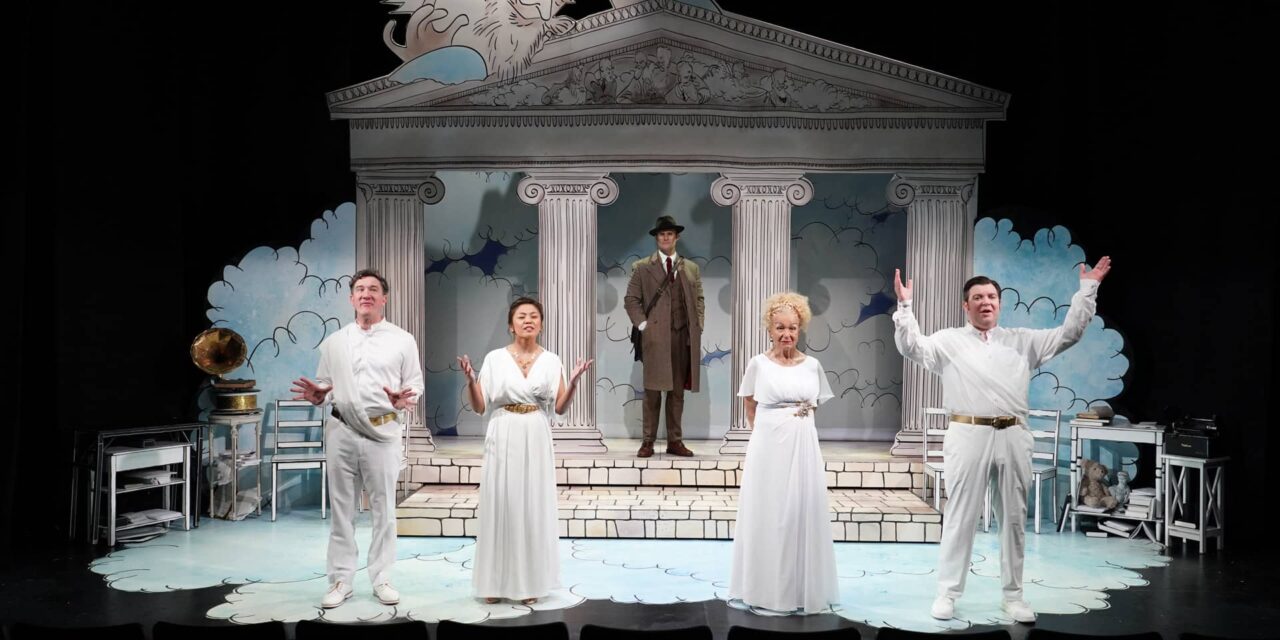Review by Ron Fassler . . .
When George Bernard Shaw’s Pygmalion first premiered in London in 1914, it boasted two of the greatest stars of the British Theatre as its leads: Herbert Beerbohm Tree as Professor Henry Higgins and Mrs. Patrick Campbell (yes, that’s how she was always billed) as Eliza Doolittle. At the time, Tree was sixty-two and Mrs. Campbell was forty-nine. Perhaps a bit long in the tooth, but no one cared, I’m sure. Shaw himself insisted she play Eliza and who was to argue? When My Fair Lady opened in 1956, the forty-eight-year-old Rex Harrison played opposite the impossibly young Julie Andrews, age twenty. In its current revival, which opened tonight for a limited run, we have the British born Marc Evans, age forty, and the twenty-nine-year-old. Synnøve Karlsen, also British born and of Norwegian background. They make for a sparkling pair in a highly enjoyable production, well directed by the Gingold Theatrical Group’s artistic head, David Staller. For someone like me, who has only read Pygmalion and never seen it onstage, this was the chance to feast on Shaw’s language, even if I was already familiar with a great deal of it due to my more than passing acquaintance with My Fair Lady.
The much beloved 1956 musical is more accurately based on Shaw’s 1938 screenplay, which won the Nobel Prize winning playwright an Academy Award, a fact few people know, or upon learning of it, find difficult to contemplate. Since the majority of Shaw’s enormous output of plays were produced before talking pictures were a thing, it’s hard to imagine he was still around a decade after they came to be (he died in 1950 at age ninety-four). The biggest surprise I came to discover is that Pygmalion very much belongs to Higgins, and not to Eliza (he’s essentially playing the title role, with the show based on the myth of the artist who falls in love with an ivory sculpture of his own creation, who gets his wish she become a real woman (Galatea). In that version, they live happily ever after. Shaw was after something different. In his version, Higgins (Pygmalion) creates his version of Eliza and doesn’t know how to deal with his feelings for her, nor she him.

Wisely, for My Fair Lady, lyricist and book writer Alan Jay Lerner and director (and major playwright himself) Moss Hart put Eliza front and center (she’s the title role now). They knew that as a musical, the show wouldn’t work if the stodgy Higgins took up more stage time than Eliza. In truth, Higgins isn’t a very nuanced character in either the play or the musical. He’s a joy for actors to play because the character is honest in his beliefs, with his chronic perfectionism and callowness extremely funny; charging around like a bull to one and all. But he changes very, very little from beginning to end while Eliza grows by leaps and bounds. It’s important to note that unlike My Fair Lady, which provided the least amount of “will they or won’t they get together” imaginable, is something Pygmalion doesn’t even concern itself with. For this reason among others, the play has taken a back seat to its musical version for damn close to seventy years. I mean, that magical score.
Here with a cast of just six (the original version when it played Broadway in 1914 had double the actors), there is a clever prologue inserted that, according to the program notes, was something Shaw dreamed up for the movie but was never filmed. His idea was to educate audiences, who might not have been familiar with the Pygmalion myth, to have Gods portrayed onscreen and show them set up the trick they plan to play on Professor Higgins, just like the one they played centuries before. It’s sort of an unnecessary bit of business, but I’ll admit to enjoying it, especially staged in the tongue-in-cheek manner with which Staller and his cast are so clearly having fun with. It’s not overly intrusive (they pop up a bit in the middle and bookend the show nicely) and the audience seemed to get a kick out of it.
As mentioned, Mark Evans makes for a younger and more vital Higgins than I’ve seen when portrayed in the musical. His speech is crisp (entirely necessary) and his Britishness is in his bones. As Eliza, Synnøve Karlsen looks and sounds the part, but needs to grow into the part a bit more. There was a tentativeness at the preview I attended; it felt like something was off about her performance. But she gave me no reason to believe she won’t get better with time. I did like Carson Elrod’s delightful Colonel Pickering very much, Higgins’ partner in crime for their “experiment,” and in a wonderful stroke of casting, Matt Wolpe has a field day with an unlikely double-casting as Alfred Doolittle, Eliza’s alcoholic father with a gift for gab, and Freddy Eynsford-Hill, her smitten suitor. This young actor pulls off the age of the older character with ease and no makeup or hair tricks and is also a natural clown as the befuddled Freddy. As Mrs. Pearce, the housekeeper of 27A Wimpole Street and Mrs. Higgins, Henry’s no-nonsense mother, Lizan Mitchell strikes a wonderful balance with her two performances. Teresa Avia Lim rounds out the cast in a series of roles with poise and flair.

Performed on a small stage with minimal props and set pieces, set designer Lindsay G. Fuori, with an able assist from the fabled theatre caricaturist Al Hirschfeld, hits on a simplicity that really works. Hirschfeld, who knew Shaw, was a major fan and drew the famous album cover for My Fair Lady that depicts Shaw as the puppeteer up in the heavens manipulating Higgins (Rex Harrison) and Eliza (Julie Andrews) as marionettes. When you enter the theatre, you get a wonderful recreation of his drawing with Shaw up in the clouds, which sets the Gods up perfectly. Tracy Christiansen has come up with all-purpose white toga-like outfits for the Gods and her costumes for Eliza are damn good for whatever the low budget she had to work with. And there’s some nice sound design from Julian Evans, with rolling thunder from time to time to accentuate a few lines, and lighting by Jamie Roderick that sets the right moods.
The Gingold Theatrical Group, dedicated to producing the plays of Shaw, has managed to do full productions or staged readings of all his sixty-five plays over a twenty-year period—a major achievement. It really is a genuine treat to see a play written 111 years ago still snap, crackle, and pop with so much to offer the ear and the heart. Go see the Gingold Theatrical Group’s Pygmalion—it’s loverly.
Gingold Theatrical Group’s Pygmalion is playing at Theater Row, Theatre 5, 410 W 42nd Street, NYC through November 22nd. For ticket information, click here:
Photos by Carol Rosegg.
Headline photo: Teresa Avia Lim, Lizan Mitchell, Carson Elrod, Matt Wolpe as Gods (foreground) and Mark Evans as Henry Higgins.


